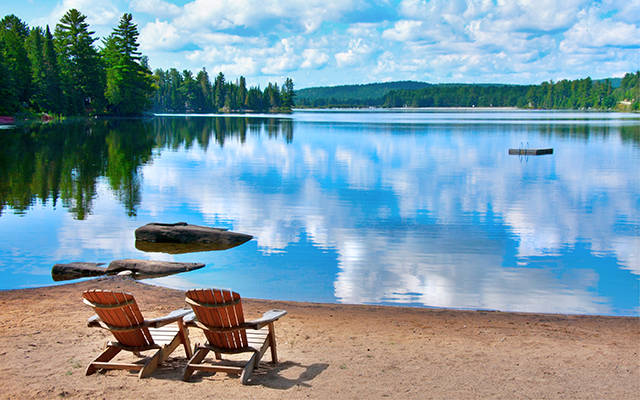Picture an island getaway, and visions of the clear blue waters of the Caribbean or the pristine beaches of Hawaii and Fiji may come to mind. Wonderful as they seem (and, let’s be honest, are), these pricey tropical destinations are, for many vacationers, largely out of reach or once-in-a-lifetime experiences.
But, before you dismiss an isle escape as one of those summer vacations you can take only in your dreams, consider this: Dotting the coastlines of the United States and sprinkled throughout the Great Lakes are hundreds of little-known islands. And, unlike common destinations like Hilton Head or Mackinac, where throngs of tourists tend to flock, these tiny, hidden gems offer local charm and off-the-beaten-path privacy along with their natural beauty.
Here, we’ve highlighted a few of our favorites so you can get a taste of what a small-island retreat is really like — and get inspired to plan one of your own.
Chillin’ in the Chesapeake: Smith Island, Md.
Looking back on her family’s getaway to Maryland’s Smith Island last summer, Kim Swanson is still amazed at how easy it was to unplug and fall into island life. “The boys didn’t turn on the TV once,” the mom of two from Columbia, Md., says. “There are no malls or bowling alleys for rainy-day entertainment, so it was so great to see them figuring out what to do on their own, the good old-fashioned way.”
That’s one of the reasons the Swansons decided to visit the 9.2-square-mile island — to be isolated from daily distractions and reconnect as a family. Instead of collapsing, exhausted, in front of the TV in the evenings, they fished and crabbed off the dock behind their inn (one of four on the island) until the bugs came out. Rather than hopping in the car to run endless errands, they jumped in the golf cart or on their ATVs. While Pierson, 14, and Garrett, 10, played with the local kids, Swanson and her husband, Peter, walked the island, taking photos, sketching and chatting with island residents.
They also spent plenty of time on the water. One afternoon, the whole family took a low-key boat tour of the 4,548-acre Martin Nationa Wildlife Refuge on the northern half of the island. They spotted herons, and Garrett hooked a stingray that snapped the line of his fishing pole as their guide navigated the boat through the tidal marshes, coves and creeks. The next day, Garrett kayaked to an undeveloped island across an inlet with the proprietor of their inn (who was also a family friend) to dig for buried treasure.
The only inhabited offshore island in Chesapeake Bay, Smith Island lies 12 miles west of Crisfield off the southern tip of Maryland, a 45-minute boat ride from the mainland. But despite Smith Island’s proximity, the lifestyle and attitudes of the 300-plus residents recall a different era. “It was a step back in time,” Swanson says. “By our third day, the locals smiled at us as if they were longtime friends.”
Great Lakes Escape: Beaver Island, Mich.
Hiking along a trail during an ecotour of Beaver Island last summer, Pete Ernst couldn’t help but marvel at the biodiversity around him: sand dunes and beaches; lakes and marshes; and pine, old-growth beech and maple forests.
“I had read about the beauty and charm of the island in history books and personal memoirs, but it was prettier than I imagined,” the New Jersey native recalls.
This nature-lover’s paradise, located 32 miles north of Charlevoix, Mich., in Lake Michigan, is the most remote inhabited island in the Great Lakes. With only 600 year-round residents, the 58-square-mile island (twice the size of Manhattan) has ample space for outdoor recreation. More than 100 miles of trails snake through its forests and along its shoreline, inviting visitors to hike or bike nearly every portion of its 43-mile perimeter. And with seven inland lakes and several nearby islands, there’s no shortage of water-based activities, from swimming and kayaking to fishing and boat tours.
Ernst scheduled his island getaway during Museum Week in July so he could learn more about the island’s heritage. “Many of the Irish-American locals were eager to share their history — how their ancestors left Ireland in the 1850s and found their way to Beaver Island because it reminded them of home,” Ernst explains. “Those chance encounters were the most rewarding part of my trip.” Within days of arriving, many locals knew Ernst by name, even stopping to offer him rides as he explored the island on foot.
Between the week’s celebrations and his own hiking and sightseeing tours, Ernst retreated to his room at the Brothers’ Place, a former monastery that has been converted to a “simple, clean and friendly” B&B. Each day, he enjoyed breakfast with fellow guests, as well as impromptu gatherings over wine and cheese at sunset.
“While there were tourists, to be sure, most of the people I met were there because they really love Beaver Island and come back every year,” Ernst says. “Everyone knows everyone — it’s small-town America at its best.”
New England Charm: Cuttyhunk Island, Mass.
Joe Barr knows that the cell-phone tower that went up on Cuttyhunk Island two years ago was needed, but he doesn’t really care to take advantage of it. “I love the isolation,” says the Needham, Mass.–based orthopaedist, an annual visitor to the tiny 1-by-2-mile atoll. Fortunately for him, modernization creeps along at a relatively slow pace compared with nearby Nantucket and Martha’s Vineyard.
Case in point: Cuttyhunk Fishing Club Bed & Breakfast Inn, the rustic 1864 inn where Barr and several members of his church’s men’s group have spent long weekends every September for the past five years, is still not winterized, and there are fewer bathrooms than guest rooms. “But it does have a well-equipped kitchen,” Barr notes, “so we can cook all the striped bass we catch each day.”
While the fishing is a key factor in bringing back Barr’s group year after year — Cuttyhunk is known for having some of the best in New England — the real draw is the opportunity to escape the chaos of everyday life for some quiet time in nature. When they’re not casting their lines from the rocky shoreline or one of their rented boats, Barr and his friends spend their downtime hiking or swimming (“the water is still reasonably warm in September,” he says). The cliff trail and deer paths that bisect the nature preserve lead to a spectacular ocean view atop Lookout Hill. That vista, says Barr, “is amazing.”
Only a few dozen people live on Cuttyhunk Island year-round, and golf carts are the sole mode of transportation, so traffic noise and congestion are nonexistent. The Fishing Club and about 25 cottage, room and apartment rentals are the only accommodations, so the passenger ferry and water taxi deliver few tourists — especially come fall, when Barr and his group visit.
“Cuttyhunk is far away from the hurly-burly of our daily responsibilities,” Barr says. “The whole pace of life slows down. Take away the cell phones, and it’s like being back in the 1950s.”
The Native Northwest: Lummi Island, Wash.
Every few months, Carla Hartnell and her husband, Randy, of Bellingham, Wash., pack up their bags and catch the six-minute ferry to Lummi Island for a quiet weekend away. “It’s small, rural, slow-paced and sweet,” says Hartnell of the northeasternmost island in the San Juan archipelago. “A friend of mine calls the line for the ferry the ‘transition lane.’ It’s a transition to another world.”
Nestled halfway between Seattle and Vancouver, the 1.5-by-9-mile Lummi (pronounced luh-mee) Island lacks the acclaim of the busier San Juan islands to its south, but has its own, more subdued allure. With just one country store, two restaurants and a handful of visitor accommodations — including one full-service inn, three family-owned B&Bs and 17 cottage rentals — this speck of land draws nature and culture lovers alike.
During their summer reprieves, the Hartnells visit the weekly farmers’ market, where the creations of local artists sit side-by-side with homegrown vegetables from the island’s two organic farms. They bike the quiet roads along the northern shoreline and hike the steep trails of the roadless southern half, spotting peregrine falcons and other migratory birds. Many visitors also love spending time on the water, paddling their sea kayaks along the rugged coast.
If they happen to be around on the right weekends, the Hartnells will also tour the open houses of artists’ homes, studios and sculpture gardens to see what’s new, and catch demonstrations of native traditions like reefnet salmon fishing, an ancient and eco-friendly technique used by the island’s original residents, the Lummi Indians — a method that is today practiced only in the San Juan archipelago.
But their favorite activity is simply relaxing and taking in the unspoiled natural setting. “I could spend hours combing the beaches for stones polished by the waves,” Hartnell says. “And to see orca whales from our view at the inn — that’s always incredible.”
Whether you’re part of a couple seeking a quiet lounge-on-the-beach weekend or a family with a wide and varied range of interests, from sightseeing to kayaking, there’s a close-to-home U.S. island to satisfy everyone’s vacation requirements. The best part? They’re accessible and affordable — and don’t require a passport.
Quiet Getaways
Isle Royale, Mich. The national park on Lake Superior’s largest island features hiking, fishing, canoeing and shipwreck scuba diving. www.nps.gov/isro
Kelleys Island, Ohio. Lake Erie’s largest island offers biking and boating, among other outdoor activities. www.kelleysislandchamber.com
Monhegan Island, Maine. Features hiking on some of Maine’s highest ocean cliffs. www.monheganwelcome.com
Oak Island, Minn. One of 14,582 islands in Lake of the Woods; located within canoeing distance of the Ontario and Manitoba borders. www.lakeofthewoodsresorts.com
Ocracoke Island, N.C. Land and sea activities are found on the 16 miles of undeveloped Cape Hatteras National Seashore beaches. www.ocracokevillage.com
Santa Cruz Island, Calif. Part of the Channel Islands National Park, Santa Cruz has a campground, four accessible beaches and about 50 miles of hiking trails. www.nps.gov/chis
Tangier Island, Va. This island’s most popular activities revolve around Chesapeake Bay: fishing, kayaking and boat tours. www.tangierisland-va.com




This Post Has 0 Comments